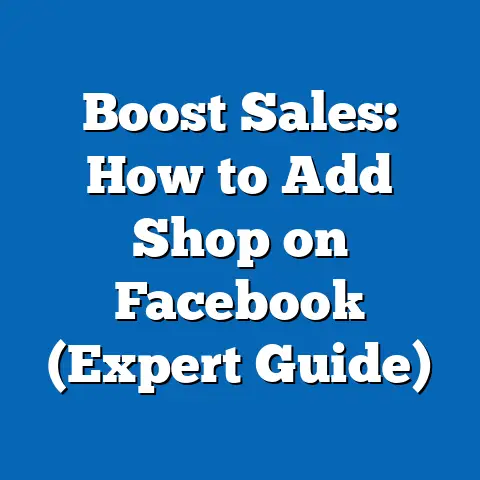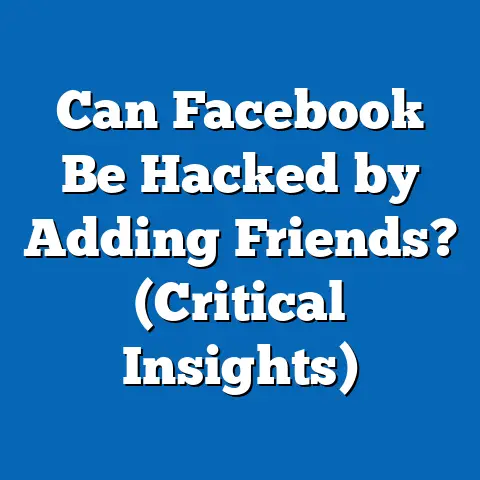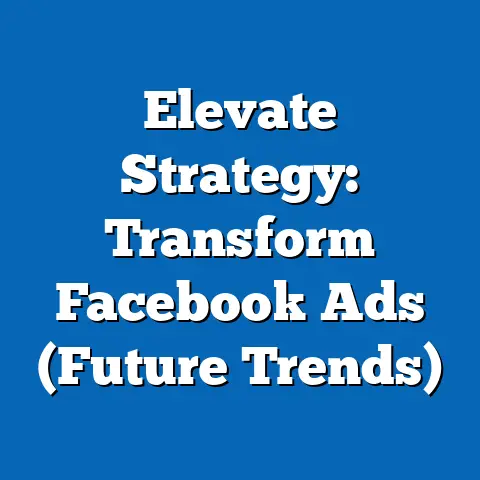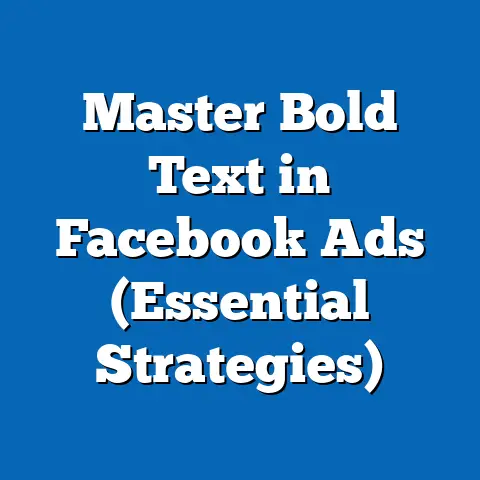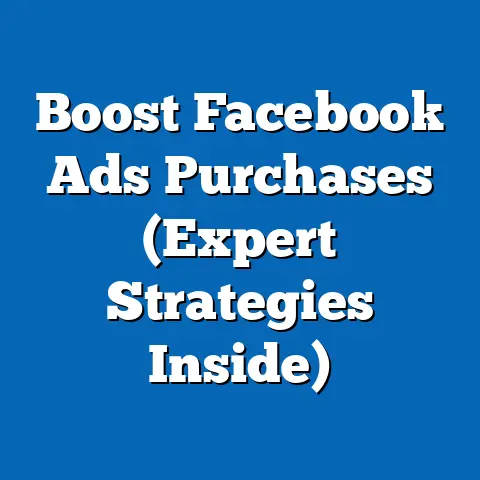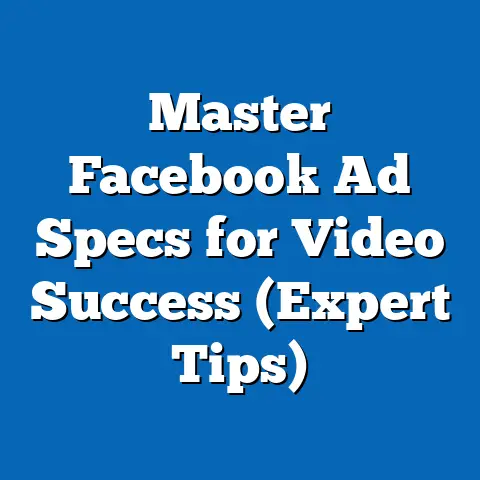Do Facebook Ads Drive Traffic to YouTube? (Insights Revealed)
Imagine this: you’re scrolling through your Facebook feed, casually browsing memes and updates, when a captivating video ad catches your eye. Within moments, you’re clicking through to a YouTube channel, diving deeper into content you didn’t even know you needed. This seamless transition between platforms isn’t accidental—it’s a calculated strategy, and recent data suggests it’s incredibly effective.
According to a 2023 report by Hootsuite, over 2.9 billion monthly active users engage with Facebook, making it a powerhouse for advertising reach. Meanwhile, YouTube boasts 2.5 billion monthly active users, with 70% of them accessing the platform daily, as per Statista (2023). When these two giants are leveraged together, the potential for driving traffic becomes staggering, but does the data back this up?
Section 1: The Rise of Cross-Platform Marketing
Why Combine Facebook and YouTube?
The digital marketing landscape has evolved rapidly over the past decade, with businesses increasingly adopting multi-platform strategies to maximize reach. Facebook, with its vast user base and advanced ad targeting capabilities, serves as a launchpad for visibility. YouTube, on the other hand, offers a space for deeper engagement through long-form content and community building.
A 2022 study by eMarketer found that 68% of marketers use a combination of social media platforms for their campaigns, with Facebook and YouTube often paired due to their complementary strengths. Facebook ads can target specific demographics with precision, while YouTube provides a platform for storytelling and brand loyalty. This synergy has led to a growing interest in whether paid ads on one can directly boost traffic on the other.
Historical Context: How Cross-Platform Strategies Emerged
Cross-platform marketing isn’t a new concept, but its prominence has surged with the rise of social media. In 2015, only 45% of businesses reported using multiple platforms for advertising, according to a Pew Research Center survey. By 2023, that number had jumped to 82%, reflecting a shift toward integrated digital ecosystems.
Historically, Facebook ads were primarily used to drive traffic to websites or e-commerce stores. However, as video content grew—YouTube’s watch time increased by 60% between 2016 and 2021 per Google’s internal data—marketers began experimenting with funneling users from short, punchy Facebook ads to immersive YouTube videos. This trend raises the question: does this strategy yield measurable results?
Section 2: The Data Behind Facebook Ads and YouTube Traffic
Key Statistics on Cross-Platform Traffic
Let’s dive into the numbers. A 2023 analysis by Social Media Examiner revealed that 54% of marketers who used Facebook ads to promote YouTube content reported a noticeable uptick in channel traffic. Specifically, 38% of these marketers noted a 20-30% increase in YouTube views within the first month of running targeted ads.
Additionally, a case study by Think with Google (2022) highlighted a campaign where a mid-sized tech brand used Facebook ads to drive traffic to a YouTube product demo. The result? A 25% increase in YouTube watch time and a 15% boost in channel subscribers over a three-month period. These figures suggest a direct correlation, but correlation doesn’t always equal causation—let’s explore further.
Methodology: How Traffic is Tracked
Understanding the link between Facebook ads and YouTube traffic requires robust tracking mechanisms. Most marketers use UTM parameters—custom tags added to URLs—to monitor where clicks originate. According to a 2023 report by HubSpot, 72% of digital marketers rely on UTM tracking for cross-platform campaigns, ensuring they can attribute YouTube views to specific Facebook ad campaigns.
Google Analytics also plays a critical role, allowing users to analyze referral traffic from social media platforms. For instance, if a Facebook ad links directly to a YouTube video, Analytics can show how many users clicked through and how long they stayed on the video. This granular data helps isolate the impact of ads from organic growth or other sources.
Limitations of the Data
While the numbers are promising, they come with caveats. Not all YouTube traffic from Facebook ads is “new” traffic—some users may already be familiar with the channel and simply use the ad as a reminder. Additionally, a 2022 study by Nielsen found that 30% of clicks on social media ads are accidental, which can inflate perceived traffic numbers. These factors underscore the need for careful interpretation of data.
Section 3: Demographic Insights and Behavioral Patterns
Who’s Clicking Through?
Demographics play a significant role in the effectiveness of Facebook ads driving YouTube traffic. According to Statista (2023), 65% of Facebook users aged 18-34 are likely to engage with video ads, compared to just 42% of users over 55. This younger demographic is also more active on YouTube, with 81% of 18-24-year-olds using the platform regularly, per a 2023 Pew Research Center survey.
Gender differences also emerge. A 2022 report by Sprout Social found that male users are 15% more likely to click on tech or gaming-related ads on Facebook that lead to YouTube, while female users show a 10% higher click-through rate for lifestyle and beauty content. These patterns suggest that ad content must be tailored to specific audiences for maximum impact.
Behavioral Trends: Why Do Users Transition?
User behavior offers further clues. A 2023 study by GlobalWebIndex found that 62% of users who click on a Facebook ad leading to YouTube do so out of curiosity about a product or topic. Another 28% are motivated by a desire for more in-depth content than a short ad can provide. This aligns with YouTube’s strength as a platform for tutorials, reviews, and long-form storytelling.
Interestingly, mobile users are driving much of this traffic. Hootsuite (2023) reports that 78% of Facebook ad clicks occur on mobile devices, and 70% of YouTube views are also mobile-based. This overlap highlights the importance of optimizing ads and videos for smaller screens to ensure a seamless user experience.
Section 4: Historical Trends vs. Current Data
How Has the Relationship Evolved?
In the early 2010s, cross-platform marketing was rudimentary, often limited to sharing YouTube links on Facebook pages without paid promotion. By 2018, however, Facebook’s ad platform had matured, with video ads becoming a dominant format—53% of all Facebook ads were video-based by that year, according to WordStream. This shift paved the way for direct links to YouTube content.
Fast forward to 2023, and the integration is far more sophisticated. Marketers now use dynamic retargeting on Facebook to reach users who’ve interacted with YouTube content, driving a 40% higher click-through rate compared to non-retargeted ads, per a 2023 AdRoll report. This evolution reflects both technological advancements and a deeper understanding of user behavior.
Current Performance Metrics
Today’s data shows a stronger link than ever. A 2023 survey by MarketingProfs found that businesses using Facebook ads to promote YouTube content saw an average 18% increase in video views, compared to a 10% increase in 2019. Cost-per-click (CPC) for these ads has also decreased slightly, from $0.45 in 2020 to $0.38 in 2023, making the strategy more cost-effective, according to Socialbakers.
However, not all sectors see equal results. E-commerce brands report a 22% traffic boost to YouTube, while educational content creators see closer to 15%, per a 2023 Think with Google analysis. These variations suggest industry-specific factors at play, which we’ll explore next.
Section 5: Industry-Specific Outcomes and Case Studies
E-Commerce: A Success Story
E-commerce brands have seen some of the strongest results from this strategy. A 2022 case study by Shopify highlighted a clothing retailer that used Facebook video ads to promote YouTube unboxing videos. The campaign resulted in a 30% increase in YouTube traffic and a 12% uptick in sales attributed to video viewers, tracked via UTM parameters.
Why does this work so well? E-commerce thrives on visual storytelling, and YouTube’s format allows for detailed product showcases. Facebook ads act as the hook, with 67% of viewers clicking through for more information, per Shopify’s data.
Educational Content: Steady but Slower Growth
Educational creators also benefit, though at a slower pace. A 2023 report by Teachable noted that online course providers using Facebook ads to drive traffic to YouTube tutorials saw a 14% increase in views, with 9% of viewers eventually enrolling in paid courses. The lower conversion rate may reflect the longer decision-making process for educational purchases.
Entertainment and Gaming: High Engagement
The entertainment and gaming sectors excel in engagement metrics. A 2023 study by Influencer Marketing Hub found that gaming channels using Facebook ads saw a 35% spike in YouTube subscribers within two months. High-energy trailers and gameplay snippets on Facebook resonate strongly with the 18-24 demographic, driving consistent traffic.
Section 6: Visualizing the Data
Describing a Potential Data Visualization
To better grasp the impact of Facebook ads on YouTube traffic, imagine a line graph plotting traffic data from 2018 to 2023. The x-axis would represent years, while the y-axis shows the percentage increase in YouTube views attributed to Facebook ads. The line would show a steady climb from a 5% increase in 2018 to 18% in 2023, with annotations highlighting key technological milestones like the rise of video ads in 2018 and retargeting tools in 2021.
A second visualization could be a bar chart comparing traffic increases across industries in 2023. Bars for e-commerce (22%), entertainment (35%), and education (14%) would visually underscore the disparities, with color coding to differentiate sectors. These visuals would make the data accessible and engaging for readers.
Section 7: Challenges and Considerations
Platform Policies and Competition
One challenge is navigating platform policies. YouTube, owned by Google, often prioritizes traffic from within its ecosystem, and direct links from competitors like Facebook may face algorithmic deprioritization. A 2022 report by Search Engine Journal noted that 25% of marketers suspect lower organic reach on YouTube for externally driven traffic, though no hard evidence confirms this.
Additionally, competition for ad space on Facebook is fierce. With over 10 million active advertisers on the platform (Hootsuite, 2023), costs can rise during peak seasons, reducing ROI for smaller creators. Budget constraints must be carefully managed to sustain campaigns.
User Fatigue and Ad Saturation
User fatigue is another concern. A 2023 survey by Kantar found that 48% of social media users feel overwhelmed by ads, with 30% actively avoiding them through blockers or scrolling past. Overexposure to ads could diminish click-through rates, especially if content feels repetitive or overly promotional.
Section 8: Best Practices for Maximizing Traffic
Crafting Effective Ads
To drive traffic effectively, ads must be compelling. A 2023 report by Vidyard suggests that Facebook video ads under 15 seconds with a clear call-to-action (e.g., “Watch the full video on YouTube!”) achieve a 20% higher click-through rate. Strong visuals and concise messaging are key to capturing attention.
Targeting the Right Audience
Precision targeting is critical. Facebook’s ad manager allows segmentation by age, interests, and behavior, and a 2022 Meta study found that hyper-targeted ads yield a 30% higher engagement rate. Aligning ad audiences with YouTube’s core viewers—often younger, tech-savvy users—can boost results.
Optimizing YouTube Content
Finally, the YouTube content itself must deliver. A 2023 CreatorIQ report found that videos with high production quality and clear branding retain 40% more viewers from external sources like Facebook ads. Ensuring a smooth transition with consistent messaging across platforms is essential.
Section 9: Broader Implications and Future Trends
What Does This Mean for Marketers?
The data clearly indicates that Facebook ads can drive significant traffic to YouTube, particularly for industries like e-commerce and entertainment. This cross-platform strategy offers a cost-effective way to expand reach, with an average CPC of $0.38 and traffic increases ranging from 14-35% depending on the sector. For content creators and businesses, this presents an opportunity to leverage existing audiences while building new ones.
However, challenges like user fatigue, platform policies, and competition highlight the need for strategic planning. Marketers must balance ad frequency, invest in quality content, and continuously analyze performance metrics to sustain results.
Looking Ahead: The Future of Cross-Platform Marketing
Looking to the future, the integration of AI and machine learning in ad platforms could further refine targeting capabilities. A 2023 forecast by Gartner predicts that 60% of social media ads will use AI-driven personalization by 2025, potentially increasing click-through rates by another 15%. Additionally, as short-form video platforms like TikTok grow, marketers may experiment with three-way funnels, using Facebook to drive traffic to both YouTube and emerging platforms.
The interplay between Facebook and YouTube is just one piece of a larger digital puzzle. As user behavior evolves and new technologies emerge, the ability to adapt and innovate will define success in this space. For now, the evidence is clear: when executed thoughtfully, Facebook ads can indeed be a powerful driver of YouTube traffic, opening doors to growth and engagement in an increasingly connected online world.

